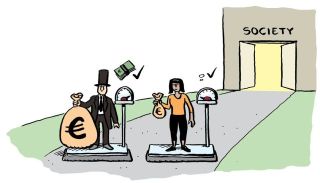Budgetary policy 2020-2025 has led to increased income gaps

Budget 2025 marked the fifth and final Budget of the coalition Government that held office from 2020-2025. This year’s edition of our analysis of the distributive effects of budget policy offers an opportunity to review the overall impact of that Governments policy choices on various household types across whole period. Our findings indicate growing income gaps, and a deterioration in the relative standing of low and middle income households. Looking at permanent (rather than once-off temporary) changes to income taxation and welfare rates over the period 2020 - 2025 our analysis provides a clearer picture of the distributive record of budgetary policy over this period. Despite welcome welfare increases, particularly for families with children, it is the highest earners who have gained most over the five budgets.
Overall, our results suggest that budgetary policy over recent years has reduced the gap between people/households of working age in the bottom and middle of the income distribution while opening a greater gap between them and those with the highest incomes. Social Justice Ireland regrets that policy outcome, as a society we can ill afford to see the incomes of those with the most resources drift further away. The deterioration in the relative standing of low and middle income households presents a troubling picture, one in which much of the recent progress on income distribution and inequality will have been reversed as a result of policy choices made. Looking ahead, reversing these growing income gaps will pose important challenges for future budgetary policy of the new Government particularly as it prepares for its first budget. The commitment to run progressive budgets in the programme for government is the context in which these income gaps must be addressed.
'Tracking Distributive Effects of Budget Policy – 2025 edition’: main findings
Distributive Analysis of Budget 2025’s Cost-of-Living and Tax-Benefit Measures
- Looking at household income changes as a result of Budget 2025 temporary measures are more concentrated among welfare dependent households and those at work but on low incomes. On the other hand, the income gains received by higher income working households are much more associated with permanent measures such as income taxation reductions.
- For example, in Budget 2025 temporary measures represented between 47-62% of the income gains for pensioners but only 11-16% of that received by couples with incomes over €100,000. Once temporary budgetary measures (such as electricity credits and one-off welfare payments) disappear, the income effect associated with permanent measures will remain and widen income divisions.
- The total weekly impact on the households examined in this analysis is large, ranging from €21 to €65 a week for welfare dependent households and from €5 to €43 a week for households with jobs.
- Within welfare dependent households the largest disposable income gains have been received by those with children. Among working households tax changes have favoured those with income subject to the higher income tax rate.
- A notable finding is that Budget 2025 provided least for the large cohort of lower income workers; those earning above the minimum wage but below annual income levels that allow them to experience much of the value of the income tax changes. A group earning around €15 to €20 per hour (€30,000 to €40,000 per annum). Social Justice Ireland has continually highlighted the relevance of refundable tax credits as a means of making the taxation system fairer and helping this low-income group.
Distributive Analysis of Tax and Welfare Measures 2020 - 2025
Comparing 2020 to 2025 for households with jobs
- Comparing 2020 to 2025 for households with jobs, the weekly income gains experienced range from €3.34 per week (for low-income couples on €30,000) to €110-120 per week for couples with incomes over €100,000.
- The analysis highlights the gaps that recent Budget policy has opened up among working households; divides visible in this analysis but missing in much of the Budgetary commentary which did not distinguish between the transitory temporary measures and the tax and welfare changes that will persist.
- For example, comparing a couple with two earners on €60,000 to a couple with two earners on €100,000, the five budgets have delivered €39.32 more per week to the higher income household; opening up a gap between these households of €2,050 per annum.
- The analysis also demonstrates how low-income working families, those with incomes below the standard rate income tax threshold, have gained least from the Government’s measures over the past five years.
Comparing 2020 to 2025 for households dependent on welfare
- Comparing 2020 to 2025 for households dependent on welfare, the gains have ranged from €42 per week for single unemployed individuals to €114 per week for unemployed couples with 2 children over 12 years of age.
- The gains are largest for welfare dependent household with children who benefited from a series of very welcome increases to the weekly qualified child allowance over the period; for children under 12 this has increased from €36 in 2020 to €50 in 2025 and for children over 12 the increase was from €40 to €62.
Income Gaps and the 2020-2025 Coalition Government
- Significant widening in the rich-poor gap was observed in 2025 driven by the end of most cost-of-living temporary supports for lower income households and the significant income taxation decreases received by well-off households in Budget 2025.
- Over the period from 2020-2025, the rich-poor gap widened by €18.45 per week (€963 per annum) meaning the gap between those with the highest incomes and those on the lowest has widened as a result of policy choices.
- Over the period from 2020-2025, the middle-poor gap decreased (by €3.92 per week, €204 per annum); an outcome driven by the skewed nature of income tax reduction choices which prioritised higher earners and provided relatively little to low income workers paying income tax at the standard rate over those years.
‘Tracking the Distributional Effects of Budget Policy – 2025 edition’ is available to download here.